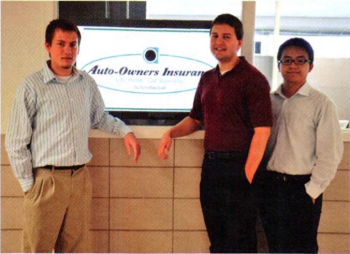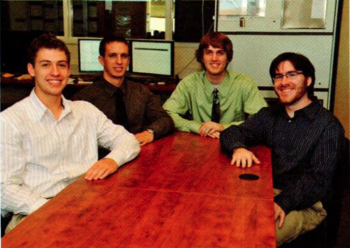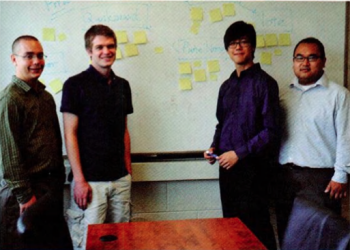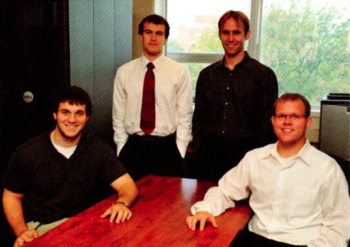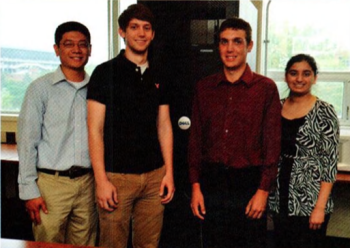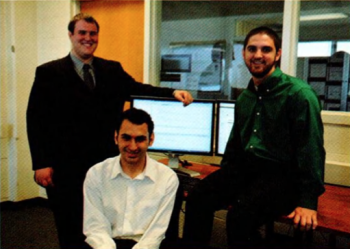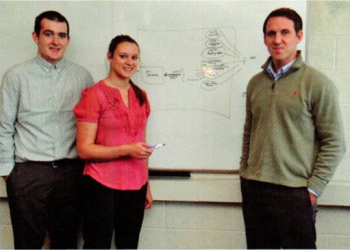Computer Science
Projects
The Capstone Experience provides the educational capstone for all students majoring in computer science at Michigan State University. Teams of students build software projects for corporate clients. For information on becoming a project sponsor, see Project Sponsorship or contact Dr. Wayne Dyksen. The following are the project sponsors and projects for the fall of 2011.
Auto-Owners Insurance: 24-Hour Road Service Mobile Apps
When going on a vacation or simply driving home from work, flat tires or other car problems
can ruin one’s day. Auto-Owners Insurance provides 24-hour road service to their customers, aiding in the acquisition of help.
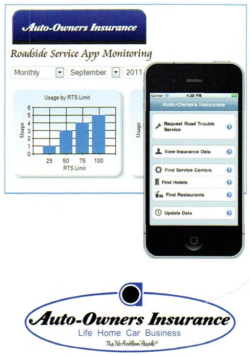 Unfortunately, when problems occur, customers often do not know their account information or their exact location. With this in mind, we have developed iPhone and Android mobile apps that store a customer’s Auto-Owners account information and have the ability to determine a customer’s exact location using the phone’s GPS in the event of trouble.
Unfortunately, when problems occur, customers often do not know their account information or their exact location. With this in mind, we have developed iPhone and Android mobile apps that store a customer’s Auto-Owners account information and have the ability to determine a customer’s exact location using the phone’s GPS in the event of trouble.
When in need of roadside assistance, a customer sends a help request to Auto-Owners with a few button presses, after which our app places a phone call on the customer’s phone to verify that a tow truck is indeed on the way.
In addition to being able to view their own account information, Auto-Owners customers can search for maps to nearby restaurants, hotels, and service centers.
As a companion to our mobile apps, we have developed a website for use by Auto-Owners Insurance associates to monitor and track the utilization of our mobile apps. Auto-Owners associates can view’ app usage by service coverage limit, state, and a variety of other parameters.
The applications are developed with Objective-C and Java. The website is built with C# using MVC3. Both use a restful web service to communicate with MySQL databases.
The Boeing Company: BAPS 2: Battle Aircraft Position Share 2
Battle Aircraft Position Share 2, or BAPS 2, is a game in which two players compete in a 3D arena to destroy their enemy’s targets, which include technology centers and planes. Players must protect their own targets by intercepting enemy communications and reacting accordingly. The game occurs in real time, with each player working to command their entire fleet through both offensive and evasive maneuvers.
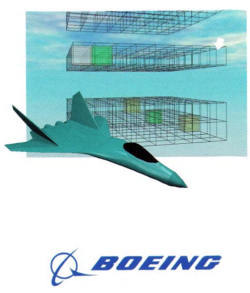 Continuous and strategic command of technology centers is essential to mounting a strong defense. In addition, each player selects a cyber-defense plan, which offers certain advantages and disadvantages, depending on whether or not the player is playing offensively or defensively.
Continuous and strategic command of technology centers is essential to mounting a strong defense. In addition, each player selects a cyber-defense plan, which offers certain advantages and disadvantages, depending on whether or not the player is playing offensively or defensively.
Players must deal with information overload and respond to feedback resulting from game events. Players who react both quickly and effectively will have an advantage in the game.
Since BAPS 2 is a web app, it can be played on many devices from different locations. The web app connects to a central game server, which keeps the game synchronized across all devices. This server also ensures that network latency does not have significant influence on the game. Communication between the web app and the game server is encrypted.
BAPS 2 is compatible with Windows XP/Vista/7. Mac OS X, Linux, Android, and iOS. The visuals are rendered in WebGL. Network connections between the game web app and the game server are made through WebSockets.
The Ford Motor Company: Ford Qwikboard
Ford is a global company that has many geographically dispersed teams. In order for these teams to be able to communicate more effectively and efficiently we have designed and written Ford Qwikboard.
 Ford Qwikboard is a ‘‘sticky note” web application that allows teams to share key ideas through text, audio, video and various office attachments. For easy organization a Qwikboard is able to be broken into different sections called panels.
Ford Qwikboard is a ‘‘sticky note” web application that allows teams to share key ideas through text, audio, video and various office attachments. For easy organization a Qwikboard is able to be broken into different sections called panels.
When a user logs in they see their current Qwikboards, can create a new Qwikboard, and they can add users with whom they will be able to collaborate. The Qwikboard is one big open space to share thoughts and ideas freely with peers.
The Qwikboard is updated in real time, which allows for instant communication and feedback. This eliminates confined conference rooms and cluttered whiteboards.
The Ford Qwikboard is a very user friendly web application that captures the natural look and feel of using ‘sticky notes’ on a whiteboard. Everything is ideally located with large buttons. Our application replaces cluttered war room processes and whiteboard brain storming with a clean and efficient virtual one accessible at any time.
Ford Qwikboard is written in HTML5 with Java, JavaScript, jQuery and multiple open source frameworks. It runs on any modern web browser or mobile device.
GE Aviation: NextGen Aircraft Taxi Assistance
Runway and taxiway collisions account for the majority of commercial airliner accidents. In fact, the deadliest accident in aviation history occurred when two Boeing 747 jumbo jets collided in dense fog on a runway in the Canary Islands.
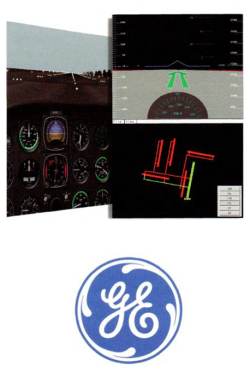 While on the ground, pilots are often challenged by a variety of competing factors including bad weather, tight schedules, and high- traffic volume. Breakdowns in communication along with limited visibility due to fog can lead to dangerous situations resulting in disastrous collisions.
While on the ground, pilots are often challenged by a variety of competing factors including bad weather, tight schedules, and high- traffic volume. Breakdowns in communication along with limited visibility due to fog can lead to dangerous situations resulting in disastrous collisions.
Our NextGen Aircraft Taxi Assistance provides pilots with an intuitive user interface that enables them to plan their ground routes, to easily navigate complicated airports, and to avoid other aircraft while taxiing to their destination. With our system, runway and taxiway collisions will be greatly reduced and possibly eliminated completely.
NextGen Aircraft Taxi Assistance is the latest addition to the MSU Next Generation Flight Deck, which is the culmination of five Capstone team projects. While nothing can replace the skills and ingenuity of an experienced flight crew, our next generation flight deck design equips pilots to operate aircraft safely and reliably better than ever even in the direst of situations.
Built with C++ and OpenGL, NextGen Aircraft Taxi Assistance is integrated with the X-Plane flight simulator to simulate aircraft taxiing and to test the use of our system.
Meijer: Tablet-Based Point-of-Sale System
With over 200 stores, Meijer continues to grow steadily because they truly value their customers. To better enhance the shopping experience. Meijer is experimenting with innovative ways to use mobile devices in the checkout process.
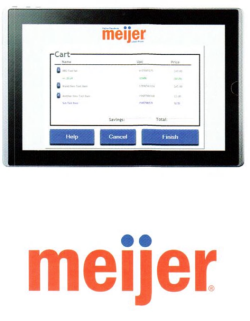 Our Tablet-Based Point-of-Sale System is a creative new interface, which provides Meijer customers with a “next generation” checkout experience.
Our Tablet-Based Point-of-Sale System is a creative new interface, which provides Meijer customers with a “next generation” checkout experience.
Our tablet-based system uses barcode scanners to identify each item to be purchased. It then sends a unique product identifier to Meijer’s Point-of-Sale system, which responds with the specific information about the item.
Shoppers interact with two tablets at the checkout station. The tablets display information about the scanned items such as their name, description, and price. Our system handles a variety of exceptions such as price or age verification.
The goal of our tablet-based system is to replace the bulky touchscreen devices that are currently in use. One important advantage is that the tablet itself is small, self-contained, and relatively inexpensive. In the event that a tablet breaks, thereby shutting down a self-checkout station, the broken tablet can easily be replaced with a working one.
Our application runs in web browsers on the two tablets. The software is written in C# with ASP.Net MVC. Data is stored in Microsoft SQL Server 2008. The UI for our system is written in HTML 5, CSS, and JavaScript.
Motorola Mobility: Synchronized Program Content Delivery
Increasingly today, consumers are improving and enhancing their lives in a variety of ways through the use of mobile devices like Android phones and tablets, iPhones, and iPads.
 While many things have changed significantly, the television viewing experience has changed relatively little in comparison.
While many things have changed significantly, the television viewing experience has changed relatively little in comparison.
To this end, the Synchronized Program Content Delivery framework provides viewers with a highly interactive, highly immersive television experience. While a viewer is watching their favorite show, an app can display auxiliary information related to the show on the viewer’s mobile devices, in sync with the show.
Advertisers can utilize our system to market their products to a targeted audience. For example, if Hugh Laurie walks in wearing your favorite athlete’s jersey, an icon would appear with a link to the website where the jersey may be purchased.
Viewers are able to sync their mobile devices via their cable box, or if they’re away from their cable box, the app can record an audio snippet of the show, identify the program, and sync accordingly. If capturing an audio snippet is not a feasible option, then the user can manually select the show on the app.
Our Synchronized Program Content Delivery service is based on a RESTful web framework using Restlet, Java, MyBatis and PostgreSQL. Our intuitive mobile apps are written using jQuery and jQuery Mobile optimized for the Motorola Xoom, and are deployed via a Glassfish server.
Sparrow Health System: iSupport Device Management System
Sparrow is mid-Michigan’s largest health provider, with a diverse range of services and facilities. Sparrow has two Lansing campuses. Sparrow Clinton Hospital. Sparrow
Ionia Hospital, Sparrow Specialty Hospital, Michigan Athletic Club, Medical Supply, Pharmacies, Medical Groups, and dozens of other satellite locations. Each of these facilities house dozens of high tech devices, which are critical to the care of their patients. In a hospital setting, keeping these devices working is a matter of life or death.
 Our iSupport Device Management System shows Sparrow IT helpdesk staff the status of hardware devices such as printers, fax machines, copiers and computers. When a device fails, our systems helps Sparrow IT staff to assist hospital staff to quickly find an alternate working device, as well as getting devices serviced more quickly.
Our iSupport Device Management System shows Sparrow IT helpdesk staff the status of hardware devices such as printers, fax machines, copiers and computers. When a device fails, our systems helps Sparrow IT staff to assist hospital staff to quickly find an alternate working device, as well as getting devices serviced more quickly.
Floor maps in the various campus buildings are displayed. A helpdesk associate can select a floor, see all the devices on that floor, and see which devices are working and not working.
A helpdesk associate adds new devices to the map and moves existing ones with a graphical drag-and-drop user interface. Devices can be identified and located on a floor map by simply searching for them using their unique device ID. New floor maps with new devices are easily added to the system.
Our iSupport Device Management System works with any web browser. It is written using ASP.NET/C#, JavaScript and jQuery. Data is managed with Microsoft SQL Server 2008.
Spectrum Health: Log Monitoring Compliance
Spectrum Health Systems is a not-for-profit healthcare system in Western Michigan. Healthcare systems manage large quantities of extremely sensitive data. Monitoring
access to this information is extremely important since it keeps medical information safe and helps Spectrum Health Systems stay in compliance with federal regulations.
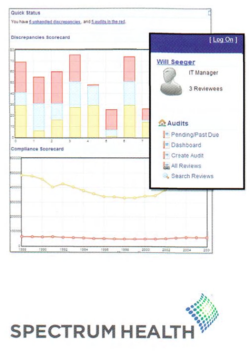 Working with Spectrum Health Technology Information Solutions, we developed Log Monitoring Compliance, a system that monitors and reviews information and configuration accesses.
Working with Spectrum Health Technology Information Solutions, we developed Log Monitoring Compliance, a system that monitors and reviews information and configuration accesses.
After an employee accesses sensitive information, that information access is logged. Our system stores this log record centrally and marks if it requires manual review. Designated reviewers can access records requiring manual review with our user application.
Within the application, a user can keep up-to-date information about each review they arc overseeing. Managers can see the compliance of their employees and track progress.
The Log Monitoring Compliance system also provides high-level summary reports of the total compliance of Spectrum Health Systems’ Technology and Information Solutions division, which allows executives to quickly see and assess the company’s adherence to audit objectives.
Our application runs in standard web browsers. The application is written in C# with the MVC Razor Engine framework and the underlying database is SQL.
TechSmith: Mobile Web Reporter
The Mobile Web Reporter enables users to make journalist style videos from their mobile devices. The app has a web browser embedded so that the user can search for relevant information in the background as well as record their audio commentary and video of their environment.
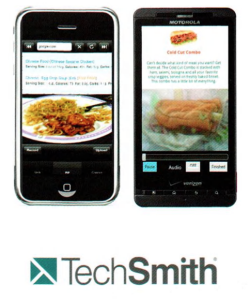 For example, let’s say that you go out to eat at a restaurant with your family and, in the middle of dinner, your friends at home ask you what you think of the place. Instead of trying to explain it to them, with the Mobile Web Reporter you are simply able to take your phone, pull up online ratings, and make a video of your experience all in real time.
For example, let’s say that you go out to eat at a restaurant with your family and, in the middle of dinner, your friends at home ask you what you think of the place. Instead of trying to explain it to them, with the Mobile Web Reporter you are simply able to take your phone, pull up online ratings, and make a video of your experience all in real time.
Once you are satisfied with your report you can save the video to your phone and continue eating, or you can upload the video to the web right away. You have the option of uploading your video to social networking websites like Facebook. In a matter of seconds your friends at home are able to see and hear what you are experiencing.
The major design challenges for the Mobile Web Reporter are recording a video that captures both the screen and camera, creating an easy to use workflow, and achieving good performance on mobile devices.
The Mobile Web Reporter is a mobile app designed for iPhone and iPad (iOS), using Objective C. and for Android, using java and C/C++. For the iPhone and iPad, videos are created in MPEG-4 format using the AV Foundation. In the Android app videos are created in WebM format using a native encoder.
Urban Science: Visual Hierarchy Selection
Urban Science is an automotive consulting company, helping manufacturers better evaluate, structure, and manage their dealer networks and marketing programs through a combination o f scientific analysis and solutions.
 In order to manage marketing and research data efficiently. Urban Science utilizes multiple hierarchical organization systems. This data is currently presented in a traditional text based manner. The goal of Visual Hierarchy Selection is to allow users to navigate through this same data in a more intuitive, modem, and visual fashion.
In order to manage marketing and research data efficiently. Urban Science utilizes multiple hierarchical organization systems. This data is currently presented in a traditional text based manner. The goal of Visual Hierarchy Selection is to allow users to navigate through this same data in a more intuitive, modem, and visual fashion.
Visual Hierarchy Selection provides a natural user experience across keyboard, mouse, and touch-based interfaces. A search feature is implemented to allow for quicker selection, both through the entire hierarchy and on each level during navigation.
Due to the variety of data managed. Visual Hierarchy Selection implements multiple display styles, allowing data to be visually represented in an appropriate manner for the content.
The hierarchical data is retrieved before it is requested by the user and stored, so that Visual Hierarchy Selection provides not only a visually appealing interface but one that is also responsive and easy to use.
Visual Hierarchy Selection is built to ran in any modem browser, using Javascript and HTML. The data is stored in an SQL database on a server running Microsoft SQL Server 2008, and retrieved using ASP.NET.
